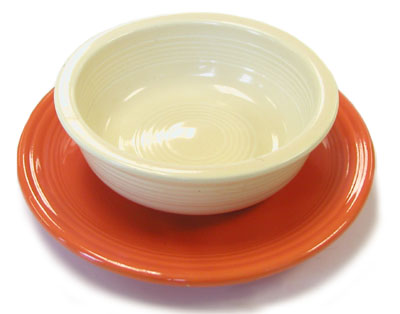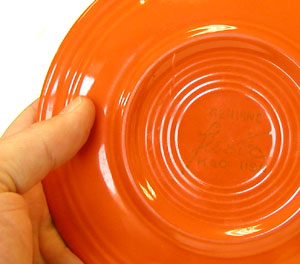Fiestaware (ca. 1930s)

The accompanying photo shows two pieces of Fiestaware produced by the Homer Laughlin Company of West Virginia: a Fiesta red saucer and an ivory bowl. In each case, uranium was used to provide the color of the glaze. Although the radioactivity of both is easily detectable, that of the Fiesta red is head and shoulders above the ivory.
It is usually said that Fiestaware came in five colors when it was introduced in 1936: red, blue, green ivory and yellow. While this might be true, the oldest newspaper account that I could find, from June of that year, only identified four: "old ivory, Chinese red, blue or green." The earliest mention of yellow that I have found was in a newspaper advertisement from January of 1937. Apparently red was the first color that the company selected when designing the product, and blue was the second (these were the colors of the Fiestaware that Andy Warhol collected). Since the idea was to mix and match, the various colors had to be compatible.
Fiesta red has always been the most popular color even though it was the most expensive. The higher price was due to the cost of the raw materials and the fact that the production of the red required a greater level of control during the firing process.

The red color was achieved by adding uranium oxide in the glaze—measurements have indicated that by weight, up to 14% of the glaze might be uranium. How much glaze was employed per plate is unclear but it has been estimated that a single plate contains 4.5 grams of uranium (Buckley et al). Piesch et al estimated the glaze thickness at 0.2 mm.
Since this uranium could be used in the production of an atomic bomb, Fiesta red became a victim of World War II when the US government confiscated the company’s stocks of uranium. Fiesta red disappeared until 1959 when production resumed, this time using depleted uranium (DU) rather than the original natural uranium. The Fiesta red plate in the above photo was made from depleted uranium while the ivory plate was made from natural uranium.
In 1969 the entire Fiestaware line was discontinued, and in its place the company produced what was known as Fiesta Ironstone. The latter, which was only manufactured in Fiesta red (aka Mango Red), didn’t last long. It was discontinued in 1973. This was the end of Fiesta red. Years later, in 1986, a new line of Fiestaware was introduced but without the red color.
- 1936-1943 – Fiesta red was produced using natural uranium
- 1959-1969 – Fiesta red Fiestaware was produced using depleted uranium
- 1969-1973 – Fiesta red Fiesta Ironstone was produced using depleted uranium
It is worth noting that the use of uranium to produce a red ceramic glaze was not limited to Fiestaware. Almost any antique ceramic with a deep orange/red color is likely to be radioactive, e.g., Caliente, Early California, Franciscanware, Harlequin, Poppytrail, Edwin M. Knowles, and Vistosa. In addition, various manufacturers, including the Homer Laughlin Company, have used uranium to give their ceramics other colors, e.g., yellow, green, brown. Buckley et al estimated that two million pieces of dinnerware between 1959 and 1969 that employed uranium containing glaze.
Estimates of the Radiation Exposures
A very detailed analysis of the radiation exposures due to uranium in dinnerware can be found in the Nuclear Regulatory Commission publication “Systematic Radiological Assessment of Exemptions for Source and Byproduct Materials” (NUREG 1717).
There are three principal radiation exposure pathways associated with Fiestaware and other uranium containing tableware:
1. Exposure to the body from the gamma rays emitted by radionuclides in the ceramic glaze
Buckley et al reported exposure rates of 0.5 and 15 mR/hr at the surface of a dinner plate and 0.002 and 0.3 mR/hr at one meter.
The following effective dose equivalent rates were reported in NUREG-1717 for the gamma rays emitted by uranium-containing dinnerware (20% by weight uranium):
| Distance | 10” Plate | 3.5” Cup |
|---|---|---|
| 1 foot | 6.5 x 10-4 mrem/hr | 3.7 x 10-4 mrem/hr |
| 3 feet | 7.7 x 10-5 mrem/hr | 4.1 x 10-5 mrem/hr |
| 6 feet | 1.9 x 10-5 mrem/hr | 1.1 x 10-5 mrem/hr |
2. Exposure to the hands from the beta particles emitted by radionuclides in the ceramic glaze
Using film badges, Menczer measured beta-gamma dose rates of 0.5 to 20 mrad/hr on contact with various items of glazed ceramic dinnerware. He calculated that the hands would receive approximately 2 to 10 rem per year as a result of handling such dinnerware 1.5 hours per day.
Piesch et al. measured 32 mrem per hour at the surface of a red ceramic teacup. Assuming daily use of the cup, they estimated an annual dose to the lips of 400 mrem and 1200 mrem to the fingers.
NUREG-1717 calculated the beta dose rates at a depth of 7 mg/cm2 (i.e., the nominal depth of the germinal layer of the skin) as well as the estimated effective dose equivalent. It was assumed that the source was a 10 inch diameter plate with a 20% by weight uranium content.
| Distance | Dose Rate | Effective Dose Equivalent Rate |
|---|---|---|
| Contact | 24 mrad/hr | 0.0024 mrem/hr |
| 1 foot | 0.84 mrad/hr | 0.0021 mrem/hr |
| 3 feet | 0.089 mrad/hr | 4.5 x 10-4 mrem/hr |
The ratio between the effective dose equivalent rate and dose rates vary with distance because the further away from the source, the greater the area of skin that was exposed.
3. Ingestion of uranium that has leached into food that has been in contact with the ceramic glaze
Kendig and Schmidt measured uranium concentrations of 1.8 to 8.6 ppm (0.6 x 10-6 to 2.9 x 10-6 uCi/ml) in acetic acid that had been in contact with red glazed ceramic dinnerware for 24 hours. The range of concentrations went up to 41 to 51 ppm (1.4 x 10-5 to 1.7 x 10-5 uCi/ml) for 60 hours of contact.
Landa and Councell measured uranium concentrations of 3.9 to 10.6 ug/liter (1.3 x 10-9 to 3.5 x 10-9 uCi/ml) in water, 470 to 31,800 ug/liter (1.6 x 10-7 to 1.1 x 10-5 uCi/ml) in acetic acid, and 96,100 to 304,000 ug/liter (3.2 x 10-5 to 1 x 10-4 uCi/ml) in nitric acid. In each case, the solutions had been in contact with the dinnerware for 24 hours. Landa and Councell noted that repeated exposure to these solutions resulted in a reduced leaching of uranium.
Based on the above leaching rates for 24 hour contact periods, NUREG-1717 estimated that an individual using nothing but this type of dinnerware might consume 0.21 grams of uranium per year. Then, using an ingestion dose factor of 1.9 x 10-4 mrem/ug, NUREG-1717 estimated that such an individual might have an effective dose equivalent of 40 mrem per year. This was the highest dose calculated in any of the exposure pathways considered by NUREG-1717.
Pertinent Regulations
10 CFR 40.13 Unimportant quantities of source material.
(c) Any person is exempt from the regulation in this part and from the requirements for a license set forth in section 62 of the Act to the extent that such person receives, possesses, uses, or transfers:...
(2) Source material contained in the following products: (i) Glazed ceramic tableware, provided that the glaze contains not more than 20 percent by weight source material;
References
- Buckley et al. Environmental Assessment of Consumer Products Containing Radioactive Material. Nuclear Regulatory Commission. NUREG/CR-1775. 1980.
- Landa, E. and Councell, T. Leaching of Uranium from Glass and Ceramic Foodware and Decorative Items. Health Physics 63 (3): 343-348; 1992.
- National Council on Radiation Protection and Measurement. Radiation Exposure of the U.S. Population from Consumer Products and Miscellaneous Sources. NCRP Report N0. 95. 1987.
- Nuclear Regulatory Commission. Systematic Radiological Assessment of Exemptions for Source and Byproduct Materials. NUREG 1717. June 2001.
- Piesch, E, Burgkhardt, B, and Acton, R. Dose Rate Measurements in the Beta-Photon Radiation Field from UO2 Pellets and Glazed Ceramics Containing Uranium. Radiation Protection Dosimetry 14 (2): 109-112; 1986.

Fiestaware: A colorful tale with an atomic twist
Fiestaware’s striking colors, particularly the iconic Fiesta red, were originally achieved with uranium oxide, making pieces radiantly unique. The use of uranium for this purpose, a practice halted and then altered due to World War II demands for atomic bomb production, underscores the blend of art and atomic science in these everyday items.
